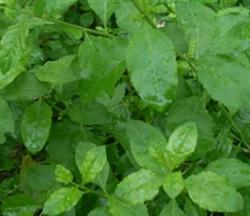Planting techniques of Lycium barbarum for leaves

The leaves of Lycium barbarum are eaten with tender shoots and leaves as vegetables, which are rich in protein, vitamins and a variety of amino acids, rutin, betaine and so on. Both protected and open fields can be planted. First, the variety types can be divided into two types: fine leaves and large leaves. The fine leaf varieties have oval leaves, the lanceolate mesophyll is thicker, the taste is thick, and the yield is low, while the large leaf varieties have thinner mesophyll, light taste and high yield. Second, the requirements of the environment like cold climatic conditions, the temperature suitable for growth is 20-25 degrees Celsius during the day and 10 degrees Celsius at night. During the day, when the temperature is above 35 degrees Celsius and below 10 degrees Celsius, the growth is poor, and sometimes the leaves will fall; they like light, especially when the basal branches sprout axillary buds and elongate branches after harvest, they require more light, but they are more shady in other periods; they need to keep the soil moist often, but are not resistant to waterlogging; they need an adequate supply of nitrogen, phosphorus, potassium and trace elements; loose and fertile loam is the most suitable. Planting season 1. Autumn and winter solar greenhouse: raising seedlings from August to September, planting from early September to mid-October, and harvesting from November to June of the following year. 2. Open field: raising seedlings in solar greenhouse from February to March, planting in early and middle April, direct cutting in mid-April, harvesting from the end of May to early June, and continued harvest in autumn if it does not blossom and bear fruit. Fourth, cutting seedlings from the robust plant cut about 15 cm long, with 2-3 seed buds of the branch, it is best to choose the base or middle of the branch, do not use the tender and weak part of the top. The upper part of the branch is cut flat, the base is cut into a horseshoe, soaked in rooting agent or fulvic acid solution for 10 minutes, and then cut into the seedbed or bed, it is best to choose sandy loam soil, oblique insertion of the branch length of 2 inch 3, pay attention to axillary buds upward, can not be inverted, spacing 10 × 10 cm, timely watering after insertion. In spring, bamboo should be used to support a small arch and cover the film to increase temperature and moisturize, and then be removed after about 2 weeks. Fifth, the planting harvest period is long to apply sufficient base fertilizer, apply more than 3000 kg of rotten and fine organic fertilizer per mu, mix it evenly with the soil, and flatten it to make a border 1.3m wide (low-lying land prone to waterlogging can be made into a high border with a width of 90cm). According to row spacing 20-30 cm, plant spacing 12-20 cm, 8000-15000 plants per mu, greenhouse planting should be dense, open field planting should be sparse. Sixth, field management slow seedling squatting seedlings for about 15 days, and ploughing and weeding 2-3 times; watering one water in 7-10 days to keep the soil moist. Drainage in time after rain in the open field. Topdressing fertilizer should be applied after the first harvest, 150 kg of "one special brand" active organic fertilizer per mu, combined with watering, and then every 20-30 days. Seventh, 50-60 days after harvest and planting, the plant height is about 50 cm, and it can be harvested. Click to get more Chinese wolfberry planting technology click to get more medicinal plant technology
- Prev

How to make Chinese wolfberry bear more fruit?
How to make Chinese wolfberry bear more fruit? Please introduce the method that Lycium barbarum is a deciduous vine shrub of Solanaceae, which blossoms twice in May-June and September-October every year, and matures one after another from August to December. In order to make Chinese wolfberry bear more fruit, it must be placed in a sunny place, resistant to drought and afraid of waterlogging. In addition to keeping the basin soil moist during the growing season, watering should be strictly controlled. Note.
- Next

What are the pests of honeysuckle?
What are the pests of honeysuckle? How to control aphids harming leaves and twigs, causing leaves and buds to curl, growth to stop and yield to decline sharply. The insect situation was serious from April to June, and it spread more quickly before and after the Beginning of Summer, especially in cloudy and rainy days. Control method: use 1000 to 1500 times dilution of dimethoate or aphid pine (killing aphids.
Related
- Fuxing push coffee new agricultural production and marketing class: lack of small-scale processing plants
- Jujube rice field leisure farm deep ploughing Yilan for five years to create a space for organic food and play
- Nongyu Farm-A trial of organic papaya for brave women with advanced technology
- Four points for attention in the prevention and control of diseases and insect pests of edible fungi
- How to add nutrient solution to Edible Fungi
- Is there any good way to control edible fungus mites?
- Open Inoculation Technology of Edible Fungi
- Is there any clever way to use fertilizer for edible fungus in winter?
- What agents are used to kill the pathogens of edible fungi in the mushroom shed?
- Rapid drying of Edible Fungi

